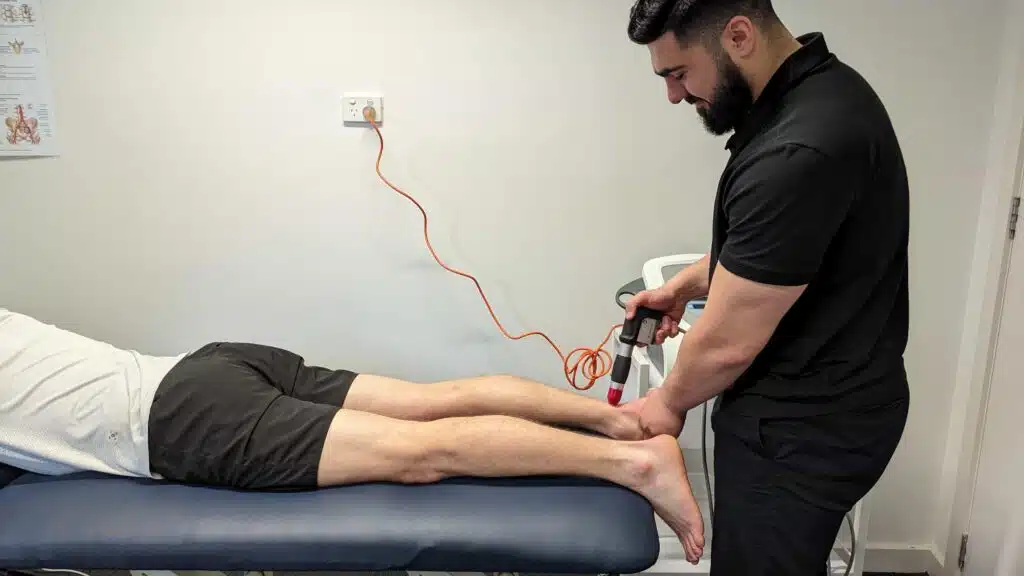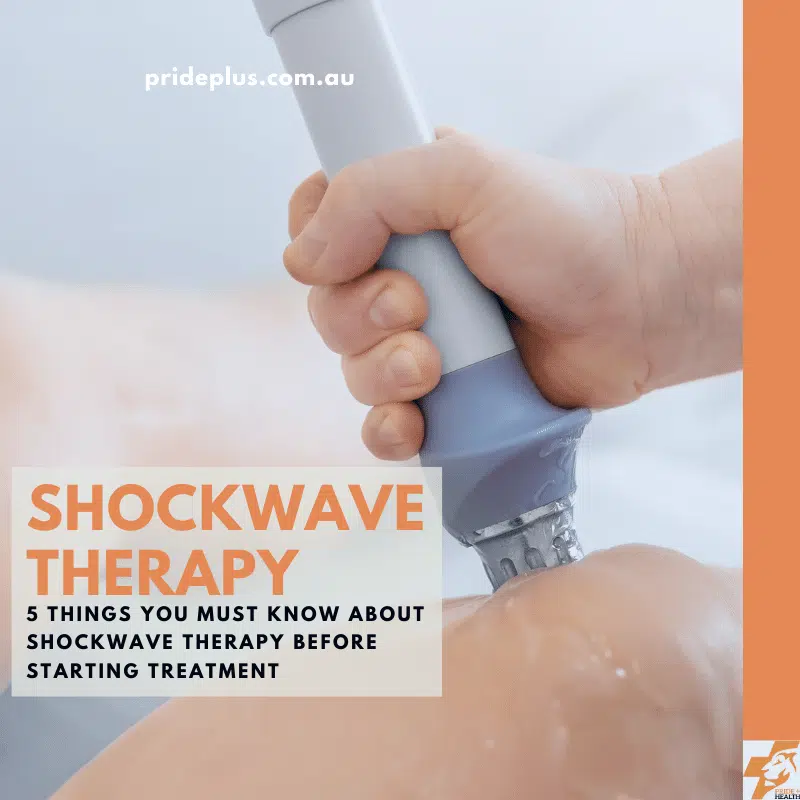In the next 5 minutes you’re going to know whether shockwave therapy is likely to be an effective treatment for your chronic pain.
So you’ve heard about shockwave therapy and want to know whether a machine can help you overcome your pain. Maybe you’re like me and a little bit sceptical? I mean, how can a machine help me when I’ve been sore for so long? I’ve tried all these other things that didn’t work surely this is just another flash in the pan.
Fair and reasonable questions to ask.
So let me walk you through shockwave therapy. I’ll share my experience as podiatrist, as a runner who battled for over a year with achilles tendinopathy, and also as a sceptical University educator who had shockwave therapy forced on me well before I thought the evidence backed up its usefulness.
After reading this post you will know:
- Is shockwave treatment likely to work for you
- How shockwave therapy works
- What shockwave treatment feels like
- How shockwave therapy forms part of an overall treatment plan
- The risks and side effects of shockwave therapy
Strap in, this could be the difference between getting sweet relief from your chronic pain or wasting time and dollars on a therapy that was never going to help you from the start.
Shockwave therapy works (sometimes)
Shockwave therapy is a safe, effective and proven treatment for some types of chronic pain.
From the data we’re confident in prescribing shockwave treatment for chronic, that is, pain that has been around for longer than 6 weeks which is caused by overloaded tendon and fascia.
The 3 most common diagnosis that respond well to shockwave are:
- Plantar fasciitis or plantar fasciopathy that has been around for more than 6 weeks
- Achilles tendonitis or achilles tendinopathy
- Lateral epicondylitis more commonly known as tennis elbow.
If you have a sore heel but it’s only just started causing you pain, or your diagnosis is something different from above you’re much less likely to feel better after a shockwave treatment session.
If you’re unsure exactly what is causing your heel pain you can see your podiatrist or try our free online heel pain test.
There are also other less common injuries which respond well to shockwave treatment but these are the big 3.
How shockwave therapy works
For me, knowing how shockwave therapy works was as important as trusting that it did.
I needed to know that the treatment I was going to undertake was safe and grounded in science and evidence. I’m also a curious cat who just wants to know how the world works anyway.
On a basic level shockwave therapy works by delivering sound waves to an injury via a probe and some ultrasound gel medium. These sound waves are non-invasive and lead to faster healing, reduced pain and injury recovery.
If you want to go deeper into understanding shockwave these are the changes which can occur.
- Stimulate collagen production that are the building blocks tendon and fascia
- Reverse chronic inflammation by triggering the release of mast cells which are required for healing but tend to reduce when our injury has been lingering for a long time
- New blood vessel formation around the injured tissue to get more nutrients to the site of your problem
- Exhaustion of your substance P which feels like a numbing sensation as you use up all of this neuropeptide.
- Break up of calcified fibroblasts essentially getting rid of poorly repaired scar like tissue to build nice healthy tissue
- Release of myofascial trigger points which are tight “knots” in the muscles that surround an injury.
If that feels a little bit too technical let’s get into something more real.
What shockwave therapy feels like
I was nervous prior to my first shockwave session as I didn’t know what to expect it would feel like.

Turns out, it felt good. But it did take me a bit to get used to.
It started for me (with my achilles tendon injury) by exposing my calf and heel to my podiatrist. They then pressed and found the injury site as well as where my tight trigger points were in my calf. Next, they popped some cool feeling ultrasound gel on those points and we kicked off the machine.
It was louder than I expected. Like a ratatatat sound that wouldn’t have been heard in the other clinic rooms but still I was surprised by the noise.
And the feeling, initially the tap-tap-tap I was feeling on my tight trigger points and sore injured achilles was uncomfortable. I knew my podiatrist was starting off at a low power and was going to get stronger and the thought of it going from uncomfortable to painful started to make me nervous.
But then as my substance P became depleted I felt a nice relaxing, numbing sensation. My podiatrist dialled up the intensity of the shockwave machine to deliver enough energy to get all 6 of the effects of the shockwave.
After about 15 minutes it was finished.
I stood up, nervous to load my achilles but it felt pretty good. These effects initially last a few hours but as the healing kicks into gear they can last much longer until you finally get full injury resolution.
Shockwave therapy as part of your treatment plan
Shockwave therapy can be useful but on its own it’s not likely to get the results you desire.
To achieve the goals you want for your injury which usually involve getting rid of the pain and returning back to performance and function it will take more than just energy waves shocking you into healing.
A comprehensive treatment plan that you establish with your podiatrist or physiotherapist will have elements of load optimisation as well as capacity building. Load optimisation is about taking your overloaded and injured tissue and reducing the peak demands on it. For example, shockwave treatment for plantar fasciitis will involve
- Getting the right shoes for your heel pain to take excess strain from your plantar fascia
- Strapping or orthotic therapy to reduce your plantar fascia load
- Gait or activity changes to limit overload
And then with capacity building you’ll be taking your injured tissue and increasing the ability for it to tolerate load. This happens in 3 places too.
- Increased capacity at the site of the injury. How shockwave therapy facilitates injury healing.
- Increased capacity of tissues close to your injury to do more work like muscles picking up the slack
- And increased capacity for your mind to tolerate loading. A huge area of recent research that relates to brain training, resilience and chronic pain.
Now you have your treatment plan it’s important to know the risks and side effects of shockwave treatment.
Shockwave therapy side effects
Every therapy has side effects and unintended consequences, and shockwave therapy has a few you need to know.
If you’re taking blood thinners (anti-coagulants) shockwave therapy can lead to bleeding around the application site. This might present as minor bruising or a more serious haematoma.
Bone cancer is a rare condition that if you already have it, can be exacerbated by shockwave. If you think about how shockwave works, by stimulating healing or growth of tissues this makes sense. While shockwave can help heal an injury it can also exacerbate a nasty process already underway.
Shockwave is also contraindicated during pregnancy.
Finally, pain or discomfort can be a side effect of shockwave therapy too. If there is pain it is usually mild and as it would happen during the application of shockwave therapy you can let your clinician know and you can cease immediately.
Now you’re equipped to decide if shockwave therapy is for you. The final details are how often and how much it will cost.
At least 3 shockwave sessions are needed
You know shockwave therapy is about healing an injury which has been present for more than 6 weeks.
As such, a single application is not going to cut it.
You’ll need at least 3 and rarely more than 6 sessions of shockwave spaced one week apart to take an injured tissue back to health again. And that is when you combine it with an appropriate treatment plan of exercise for capacity building of muscles as well as load optimisation.
The cost of shockwave therapy is $15 per treatment on top of your podiatry or physiotherapy session fees. This means if you have coverage under your private health insurance for podiatry or physio you’ll get rebates to ease the access to your treatment.
I hope you’re now ready to either say no, shockwave is not for me, or yes, I’m ready to start my treatment.
By now you’re armed with the knowledge I had to learn the hard way. By reading the research and having a nervous time with my colleague shocking my achilles before I had made up my mind.
If you have further questions I’d suggest discussing these in detail with your podiatrist or your physiotherapist.
About the Author

Tim Mulholland is a podiatrist based in Melbourne CBD and also consults in our Pascoe Vale podiatry clinic. He’s also a keen runner and someone who has struggled with overuse injuries in the past.
When not consulting, or teaching at La Trobe University you’ll find him running around Royal Park, cheering on the Cats, and socialising with friends.
References
- The effectiveness of extracorporeal shock wave therapy in lower limb tendinopathy: a systematic review (2014)
- Extracorporeal shock wave therapy is effective in treating chronic plantar fasciitis: a meta-analysis of RCTs (2013).
- The biological effects of extracorporeal shock wave therapy (eswt) on tendon tissue (2012)
- Don’t start shockwave therapy in Melbourne without reading this first.




